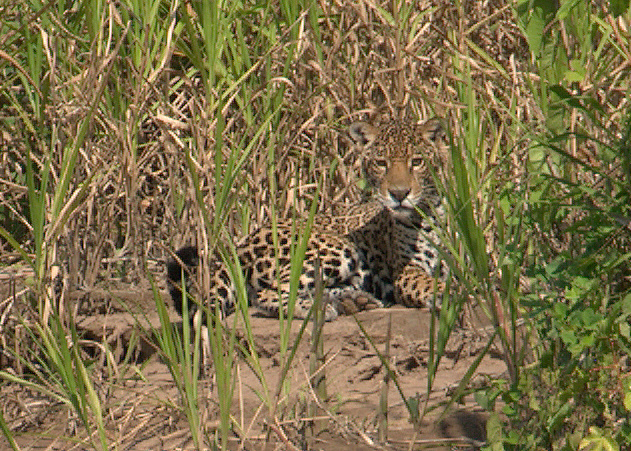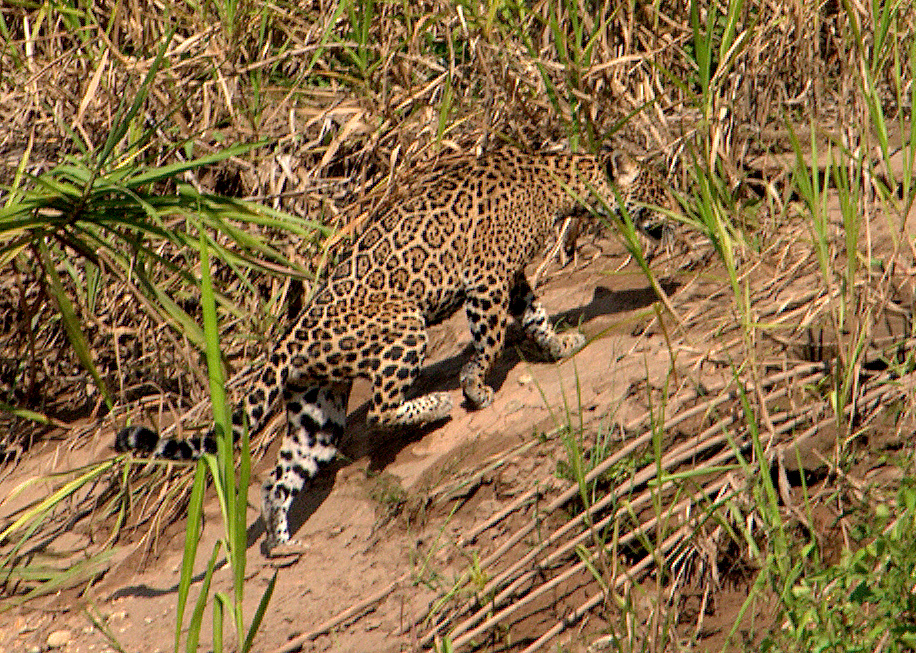General information
- Genus: Panthera
- Species: Onca
- Average length: 1.6 – 2.2 m (5 – 7 ft.). Females normally 10 – 20% smaller.
- Adult weight: 42 – 100kg (93 – 220 lb.)
- Diet: Over 85 species, most notably peccaries, capybaras, pacas, agoutis, armadillos, caimans and turtles. Others include tapirs, monkeys, otters, sloths, anteaters, tortoises and anacondas.
- Natural predators: None (at the top of its food chain). Young are said to be preyed on by other jaguars, caimans and large snakes.
- Life span in the wild: 11 years
- Litter size: One to four, usually two
- Natural habitat: Primarily near water. Rainforest, swamp areas, pampas grasslands, thorn scrub woodlands and dry deciduous forest. In lowland areas but they have been reported up to 3,000 m (10,000 ft.).
- Geographical range: Some parts of Mexico, from Belize down to northern Argentina and from Ecuador to Guyana and eastern Brazil.
Interesting Jaguar facts
- The Jaguar is the only species of the Panthera family found in the Americas. This family includes jaguars, lions, tigers and leopards.
- It is the largest of all cat species present in the Americas (others include the Puma, Ocelot and Jaguarundi).
- They are known to prey on over 85 different species, including species that live on land, in the water and even in trees (jaguars will climb to the lower branches).
- Jaguars usually kill their prey with a bite through the nape (the back of the neck) or with larger prey, they jump on them and make the animal fall to the floor, breaking its neck. Sometimes they kill by biting through the skull – a unique technique among cats.
- Unlike many other cat species, the jaguar does not avoid water – in fact, it is a very capable swimmer and often preys on turtles and caimans.
- This animal was once found from south-western United States through the Amazon basin to the Rio Negro in central – southern Argentina but has seen its geographical distribution reduced by over 50% due to habitat loss and poaching. It is now extinct in the United States, El Salvador, Uruguay and parts of other countries where it once resided.
- Jaguars are said to descend from cats from Asia that millions of years ago migrated to the Americas by crossing the Bering land bridge that once connected the continent with Asia.
- Jaguars are blind and cannot walk at birth. Their eyes open at approximately 8 days and they are able to walk at around 18 days.
- Females do not allow males near young because they may eat them.
- The name “jaguar” is said to come from “yaguara” in a Tupi-Guarani language, which means “wild beast that overcomes its prey at a bound”.
- In many Pre-Columbian cultures, the jaguar was an important symbol of power and strength. For the Mayans, they were their companions in the spiritual world and aided communication between the living and the dead.
- The Jaguar is the national animal of Guyana (its national bird is the Hoatzin).
IUCN conservation assessment
- Estimated world population: Unknown
- Conservation status: Near Threatened (likely to qualify as Vulnerable in the near future)
- Population trend: Decreasing
Sources
- Panthera onca – Seymour, K. L.
- IUCN Cat Specialist Group
- Caso, A., Lopez-Gonzalez, C., Payan, E., Eizirik, E., de Oliveira, T., Leite-Pitman, R., Kelly, M. & Valderrama, C. 2008. Panthera onca. In: IUCN 2012. IUCN Red List of Threatened Species. Version 2012.2. Downloaded on 18 May 2013.

Jaguar seen in Tambopata

Jaguar climbing river bank in Tambopata
